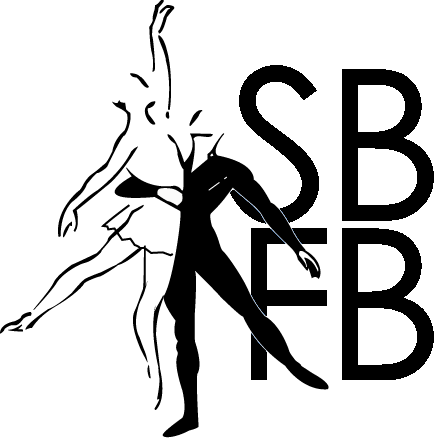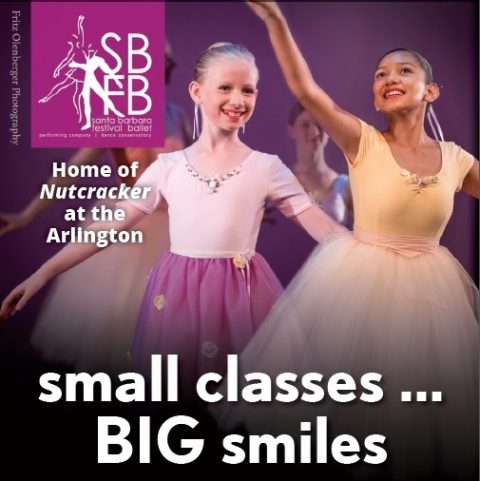The Santa Barbara Nutcracker History
SBFB’s Nutcracker at the Arlington is a true Santa Barbara holiday tradition for over four decades
Our Audience:
Over 3200 audience members join us during the holiday season, always the second weekend in December, to experience Nutcracker at the Arlington. Year after year, we celebrate the wonder and wide-eyed excitement of families strolling through the lobby doors, with anticipation of watching Herr Drosselmeyer’s dolls come to life and the magical Christmas Tree growing up beyond the stage before them. Young children with ‘Nutcracker’ or ‘Clara’ in hand, are escorted down the aisle by a parent or grandparent who also grew up with this production, eager to find their seats as the live orchestra warms their instruments and the music begins. As they gaze in awe at the historic Arlington Theatre, their imaginations drift to the ‘Kingdom of Sweets’ and a true holiday tradition unfolds once more.
This audience reflects a multigenerational, multicultural mix that beautifully represents our community. We pull from the ARTS world at many levels, those who love the opportunity to hear Tchaikovsky’s brilliant music played as intended by a live, full symphony orchestra to those who are mesmerized by the grace of a classic ballet. Being one of the largest holiday productions on the Central Coast, and celebrating a rich long history of consecutive runs, Nutcracker at the Arlington is well known and attended. This production is truly Santa Barbara’s Nutcracker.
Our Conductors and Symphony Orchestra Musicians:
Ronald Ondrejka, Frank Collura and Varujan Kojian all conducted The Nutcracker during their respective tenures as Musical Director of the Santa Barbara Symphony. But none has taken the podium as often as Elise Unruh. Ms Unruh first conducted the production in 1987 at Maestro Kojian’s invitation. She was asked again in 1993 and has conducted every year since then. A special acknowledgment was given to Elise Unruh on her 20th consecutive year conducting our community’s cherished Nutcracker at the Arlington Symphony Orchestra during the 2012 production.
All of our fine musicians either are or have been members of our illustrious Santa Barbara Symphony or have performed with them many times in the past. Jack Ullom, Jeanne Ullom , Gloria Autry, Jeanne Shumway, Francine Jacobs, Gladys Secunda and Sara Banta have each performed in more than 30 productions of our Nutcracker at the Arlington. Paul Bambach and Alita Rhodes have been with us for over 20 years, with Steve Gross, Jon Lewis and Andrew Malloy having played for many years in the past, are with us again this year. Our current Concertmaster, Miran Kojian, has been with us over 25 years! Contractor Jeanne Ullom has gathered this musical family of friends together for over 30 years.
Our Cast:
Santa Barbara Festival Ballet celebrated a mile-stone during our 2012 performance , having cast over 1000 students of the conservatory since 1975, to perform in our Nutcracker at the Arlington! The cast is often comprised of Nationally and Internationally recognized Guest Artists, SBFB company dancers and students of the conservatory, SBFB Alumni, UCSB Department of Dance students, the UCSB Dance Company, and members of our community.
Thank You For Being With Us, And A Very Happy Holidays To All!
Cindy Bates Elster, Past President
The Classic Nutcracker History
Enjoy this history compilation of The Nutcracker worldwide.
The Nutcracker (Russian: Щелкунчик, Балет-феерия / Shchelkunchik, Balet-feyeriya; French: Casse-Noisette, ballet-féerie) is a two-act ballet, originally choreographed by Marius Petipa and Lev Ivanov with a score by Pyotr Ilyich Tchaikovsky (op. 71). The libretto is adapted from E.T.A. Hoffmann‘s story The Nutcracker and the Mouse King. It was given its première at the Mariinsky Theatre in St. Petersburg on Sunday, 18 December 1892, on a double-bill with Tchaikovsky’s opera, Iolanta.[1]
Although the original production was not a success, the twenty-minute suite that Tchaikovsky extracted from the ballet was. However, the complete Nutcracker has enjoyed enormous popularity since the late 1960s and is now performed by countless ballet companies, primarily during the Christmas season, especially in the U.S.[2] Major American ballet companies generate around 40 percent of their annual ticket revenues from performances of The Nutcracker.[3][4]
Tchaikovsky’s score has become one of his most famous compositions, in particular the pieces featured in the suite.[5]Among other things, the score is noted for its use of the celesta, an instrument that the composer had already employed in his much lesser known symphonic ballad The Voyevoda.
After the success of The Sleeping Beauty in 1890, Ivan Vsevolozhsky, the director of the Imperial Theatres, commissioned Tchaikovsky to compose a double-bill program featuring both an opera and a ballet. The opera would be Iolanta. For the ballet, Tchaikovsky would again join forces with Marius Petipa, with whom he had collaborated onThe Sleeping Beauty. The material Petipa chose was an adaptation of E.T.A. Hoffmann’s story The Nutcracker and the Mouse King by Alexandre Dumas père called The Tale of the Nutcracker.[1] The plot of Hoffmann’s story (and Dumas’ adaptation) was greatly simplified for the two-act ballet. Hoffmann’s tale contains a long flashback story within its main plot entitled The Tale of the Hard Nut, which explains how the Prince was turned into the Nutcracker. This had to be excised for the ballet.[6]
Petipa gave Tchaikovsky extremely detailed instructions for the composition of each number, down to the tempo and number of bars.[1] The completion of the work was interrupted for a short time when Tchaikovsky visited the United States for twenty-five days to conduct concerts for the opening of Carnegie Hall.[7] Tchaikovsky composed parts of The Nutcracker in Rouen, France.[8]
History
| Ballets by Pyotr Ilyich Tchaikovsky |
|---|
 Swan Lake (1876) Swan Lake (1876)Sleeping Beauty (1889) The Nutcracker (1892) |
St. Petersburg première
The first performance of the ballet was held as a double premiere together with Tchaikovsky’s last opera, Iolanta, on 18 December [O.S. 6 December] 1892, at the Imperial Mariinsky Theatre in St. Petersburg, Russia. Although the libretto was by Marius Petipa, who exactly choreographed the first production has been debated. Petipa began work on the choreography in August 1892; however, illness removed him from its completion and his assistant of seven years, Lev Ivanov, was brought in. Although Ivanov is often credited as the choreographer, some contemporary accounts credit Petipa. The performance was conducted byRiccardo Drigo, with Antonietta Dell’Era as the Sugar Plum Fairy, Pavel Gerdt as Prince Coqueluche, Stanislava Belinskaya as Clara, Sergei Legat as the Nutcracker-Prince, and Timofei Stukolkin as Drosselmeyer. The children’s roles, unlike many later productions, were performed by real children rather than adults (with Belinskaya as Clara, and Vassily Stukolkin as Fritz), students of Imperial Ballet School of St. Petersburg.
The first performance of The Nutcracker was not deemed a success.[9] The reaction to the dancers themselves was ambivalent. While some critics praised Dell’Era on her pointework as the Sugar Plum Fairy (she allegedly received five curtain-calls),[2] one critic called her “corpulent” and “pudgy.”[1] Olga Preobrajenskaya as the Columbine doll was panned by one critic as “completely insipid” and praised as “charming” by another.[2] One audience member described the choreography of the battle scene as confusing: “One can not understand anything. Disorderly pushing about from corner to corner and running backwards and forwards – quite amateurish.”[2]
The libretto was criticized for being “lopsided”[2] and for not being faithful to the Hoffmann tale. Much of the criticism focused on the featuring of children so prominently in the ballet,[10] and many bemoaned the fact that the ballerina did not dance until theGrand Pas de Deux near the end of the second act (which did not occur until nearly midnight during the program).[2] Some found the transition between the mundane world of the first scene and the fantasy world of the second act too abrupt.[1] Reception was better for Tchaikovsky’s score. Some critics called it “astonishingly rich in detailed inspiration” and “from beginning to end, beautiful, melodious, original, and characteristic.”[2] But even this was not unanimous as some critics found the party scene “ponderous” and the Grand Pas de Deux “insipid.”[10]
Subsequent productions
In 1919, choreographer Alexander Gorsky staged a production which eliminated the Sugar Plum Fairy and her Cavalier and gave their dances to Clara and the Nutcracker Prince, who were played by adults instead of children. His was the first production to do so. An abridged version of the ballet was first performed outside Russia in Budapest (Royal Opera House) in 1927, with choreography by Ede Brada.[11] In 1934, choreographer Vasili Vainonen staged a version of the work that addressed many of the criticisms of the original 1892 production by casting adult dancers in the roles of Clara and the Prince, as Gorsky had. The Vainonen version influenced several later productions.[1]
The first complete performance outside Russia took place in England in 1934,[9] staged by Nicholas Sergeyev after Petipa’s original choreography. Annual performances of the ballet have been staged there since 1952.[12] Another abridged version of the ballet, performed by the Ballet Russe de Monte Carlo, was staged in New York City in 1940, [13]Alexandra Fedorova – again, after Petipa’s version.[9] The ballet’s first complete United States performance was on 24 December 1944, by the San Francisco Ballet, staged by its artistic director Willam Christensen.[9] The New York City Balletgave its first annual performance of George Balanchine‘s staging of The Nutcracker in 1954.[9] Beginning in the 1960s, the tradition of performing the complete ballet at Christmas eventually spread to the rest of the United States.
Since Gorsky, Vainonen and Balanchine’s productions, many other choreographers have made their own versions. Some institute the changes made by Gorsky and Vainonen while others, like Balanchine, utilize the original libretto. Some notable productions include those by Rudolf Nureyev for the Royal Ballet, Yuri Grigorovich for theBolshoi Ballet, Mikhail Baryshnikov for the American Ballet Theatre, and Peter Wright for the Royal Ballet and the Birmingham Ballet. In recent years, revisionist productions, including those by Mark Morris, Matthew Bourne, and Mikhail Chemiakin have appeared; these depart radically from both the original 1892 libretto and Vainonen’s revival, while Maurice Bejart‘s version completely discards the original plot and characters. In addition to annual live stagings of the work, many productions have also been televised and/or released on home video.[2]
Synopsis
Below is a synopsis based on the original 1892 libretto by Marius Petipa. The story varies from production to production, though most follow the basic outline. The names of the characters also vary. In the original E.T.A. Hoffmann story, the young heroine is called Marie Stahlbaum and Clara (Klärchen) is the name of her doll. In the adaptation by Dumas on which Petipa based his libretto, her name is Marie Silberhaus.[6] In still other productions, such as Baryshnikov’s, Clara is Clara Stahlbaum rather than Clara Silberhaus.
Act I
Scene 1: The Silberhaus Home
It is Christmas Eve. Family and friends have gathered in the parlor to decorate the beautiful Christmas tree in preparation for the night’s festivities. Once the tree is finished, the younger children are sent for. The children stand in awe of the tree sparkling with candles and decorations.
The festivities begin. A march is played. Presents are given out to the children. Suddenly, as the owl-topped clock strikes eight, a mysterious figure enters the room. It is Herr Drosselmeyer, a local councilman, magician, and Clara and Fritz’s godfather. He is also a talented toymaker who has brought with him gifts for the children, including four lifelike dolls who dance to the delight of all. Drosselmeyer then has the precious dolls put away for safekeeping.
Clara and Fritz are sad to see the dolls taken away, but Drosselmeyer has yet another toy for them: a wooden nutcracker carved in the shape of a little man, used for cracking hazelnuts. The other children ignore it, but Clara immediately takes a liking to it. Fritz, however, purposely breaks the toy. Clara is heartbroken.
During the night, after everyone else has gone to bed, Clara returns to the parlor to check on her beloved nutcracker. As she reaches the little bed, the clock strikes midnight and she looks up to see Drosselmeyer perched atop the clock in place of the owl. Suddenly, mice begin to fill the room and the Christmas tree begins to grow to dizzying heights. The Nutcracker also grows to life-size. Clara finds herself in the midst of a battle between an army of Gingerbread man soldiers and the mice, led by the Mouse King. The mice begin to eat the gingerbread soldiers.
The Nutcracker appears to lead the gingerbread soldiers, who are joined by tin soldiers and dolls who serve as doctors to carry away the wounded. As the Mouse King advances on the still-wounded Nutcracker, Clara throws her slipper at him, distracting him long enough for the Nutcracker to stab him.
Scene 2: A Pine Forest
The mice retreat and the Nutcracker is transformed into a handsome Prince. He leads Clara through the moonlit night to a pine forest in which the snowflakes dance around them.
Act II
Scene 1: The Land of Sweets
Clara and the Prince travel in a nutshell boat pulled by dolphins to the beautiful Land of Sweets, ruled by the Sugar Plum Fairy in the Prince’s place until his return. The Prince recounts for the Sugar Plum Fairy how he had been saved by Clara from the Mouse King and had been transformed back into a Prince.
In honor of the young heroine, a celebration of sweets from around the world is produced: chocolate from Spain, coffee from Arabia, and tea from China all dance for their amusement; candy canes from Russia; Danish shepherdesses perform on their flutes; Mother Gigogne has her children emerge from under her enormous skirt to dance; a string of beautiful flowers perform a waltz. To conclude the night, the Sugar Plum Fairy and her Cavalier perform a dance.
A final waltz is performed by all the sweets, after which Clara and the Prince are crowned rulers of The Land of Sweets. Soon, however, the people of the land of the sweets begin to disappear one by one, until the Nutcracker Prince himself disappears, and Clara is found sleeping in the parlor. The Nutcracker Doll is under the Christmas tree. Clara awakes, thinking it was all a dream, but then finds her crown sitting beside her, leading to question, was it a dream? She walks to the Christmas tree and takes her Nutcracker, going back to sleep, the implication being that if it was all a dream, that she would want to keep dreaming.
Continued on *Source WikiPedia




